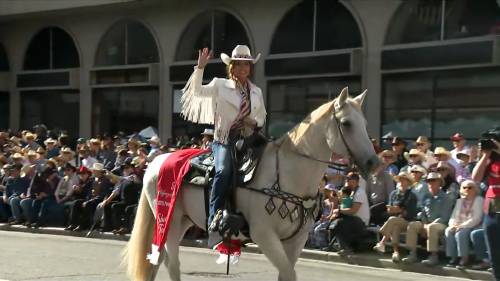The streets of Calgary transformed into rivers of color and sound this morning as the 2025 Calgary Stampede kicked off with its signature parade—a spectacle that continues to capture the essence of Western Canadian heritage while evolving with the times.
Under pristine blue skies, thousands lined the downtown route before dawn, clutching coffee cups and claiming prime viewing spots for what has become more than just a parade, but rather a cultural touchstone for the city. Children perched on parents’ shoulders, their eyes wide as the first horseback riders rounded the corner, flags snapping in the gentle summer breeze.
This year’s parade marshal, celebrated Indigenous environmental activist Sarah Running Wolf, led the procession with dignified grace, representing the deepening relationship between the Stampede and First Nations communities. Her presence symbolized the event’s ongoing journey toward inclusivity—a notable shift from its earlier incarnations.
“The Stampede Parade has always been about storytelling,” explained cultural historian Marie Doucette, who has documented the evolution of the event for over two decades. “What’s fascinating is how those stories have expanded to embrace the full spectrum of Western Canadian identity.”
Indeed, this year’s parade featured a striking blend of traditional elements and contemporary flair. The thundering hooves of the Mounted Police musical ride shared the route with innovative floats highlighting Calgary’s burgeoning tech sector. Traditional Indigenous dancers performed alongside multicultural groups, creating visual dialogues between past and present.
For many attendees, the agricultural elements remain the heart of the parade. The prize-winning Clydesdale horses drew audible gasps as they passed, their massive hooves seeming to shake the very pavement. Meanwhile, rural community floats celebrated the farming heritage that remains vital to Alberta’s identity despite the province’s increasing urbanization.
The parade’s sensory experience defines it as much as the visual spectacle. The distinctive aroma of leather and saddle soap mingled with the scent of food vendors preparing for the day ahead. The soundscape shifted constantly—from brass bands to drumming circles, from children’s excited shrieks to the rhythmic clop of horse hooves.
Weather cooperated magnificently this year, unlike the downpour that dampened—but failed to diminish—last year’s enthusiasm. The sunshine seemed to amplify both colors and spirits, with attendance numbers appearing to surpass recent years according to early estimates from organizers.
Local businesses have embraced the economic boost the Stampede brings, with storefronts decorated in western themes stretching well beyond the parade route. The annual event generates approximately $282.5 million in economic activity for the city—particularly welcome following several challenging years for Alberta’s economy.
What makes the Stampede Parade particularly fascinating from a cultural perspective is how it navigates the tension between nostalgia and progress. While celebrating cowboy culture and frontier mythology, it increasingly acknowledges the complexities of that history while looking toward the future.
“You’re seeing a parade that honors tradition while refusing to be trapped by it,” noted social trend analyst Jordan Michaels. “That’s why it remains relevant when many similar events across North America have faded or become mere tourist curiosities.”
As the final floats passed and street cleaners appeared with remarkable efficiency, conversations among departing spectators revealed the parade’s impact. Families debated favorite moments, visitors from abroad expressed surprise at the scale and energy, and longtime Calgarians compared this year’s offering to those of decades past.
The 2025 Calgary Stampede Parade succeeded in its primary mission—setting the tone for the ten-day festival that follows. It offered a reminder that while our understanding of Western heritage continues to evolve, the communal experience of celebration remains a powerful force in shaping civic identity.
As the crowds dispersed toward Stampede Park or back to offices and homes, they carried with them not just commemorative programs and smartphone photos, but a renewed connection to a community ritual that somehow manages to feel both timeless and perfectly attuned to the moment.
The greatest achievement of this year’s parade might be that it left us with questions worth considering: How do we honor tradition while acknowledging its complexities? How do communities maintain distinctive identities in a globalizing world? And how might celebrations like the Stampede continue evolving to reflect our changing understanding of history and identity?
The answers, like the parade itself, will continue unfolding in the years ahead.










